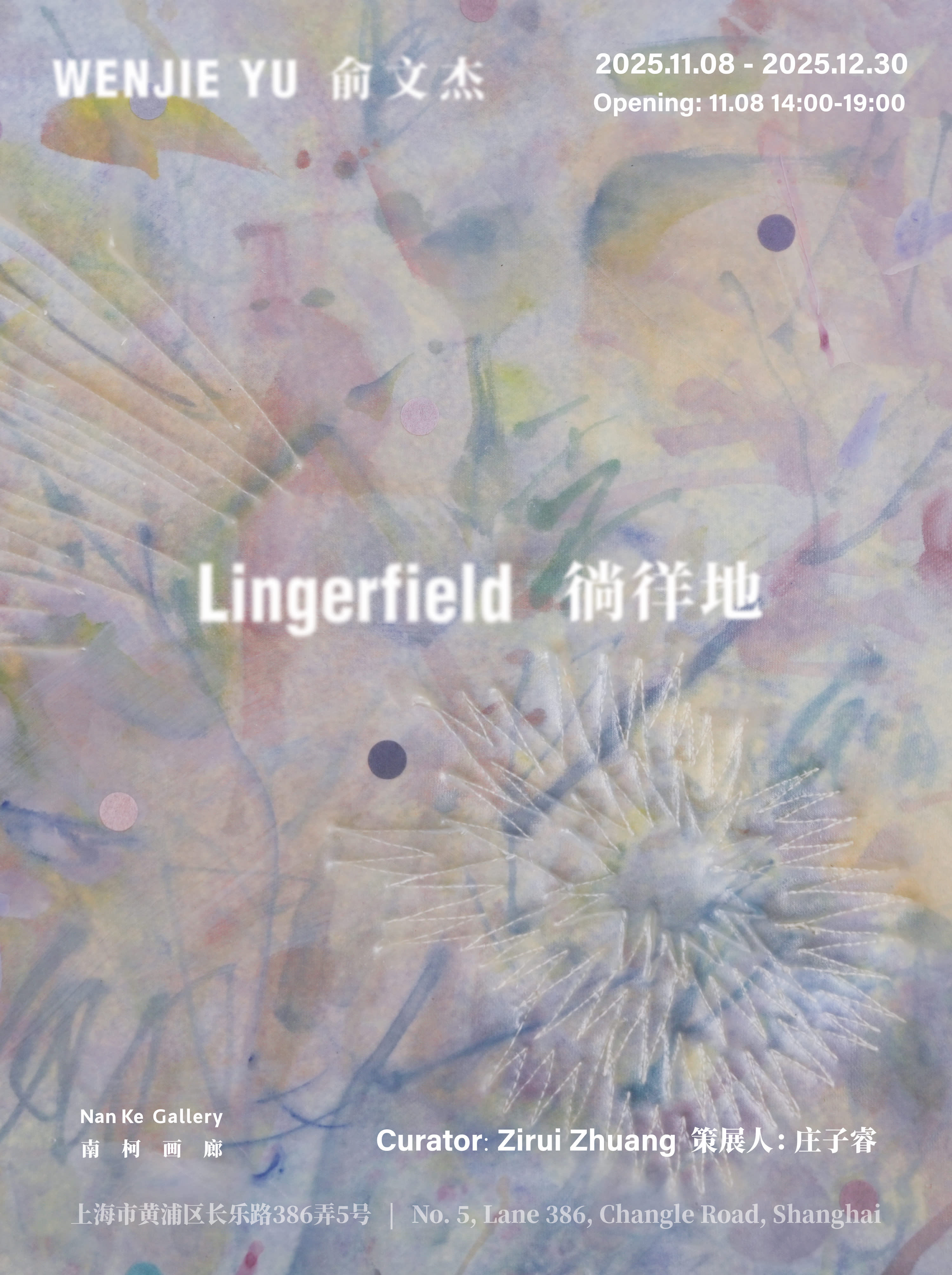
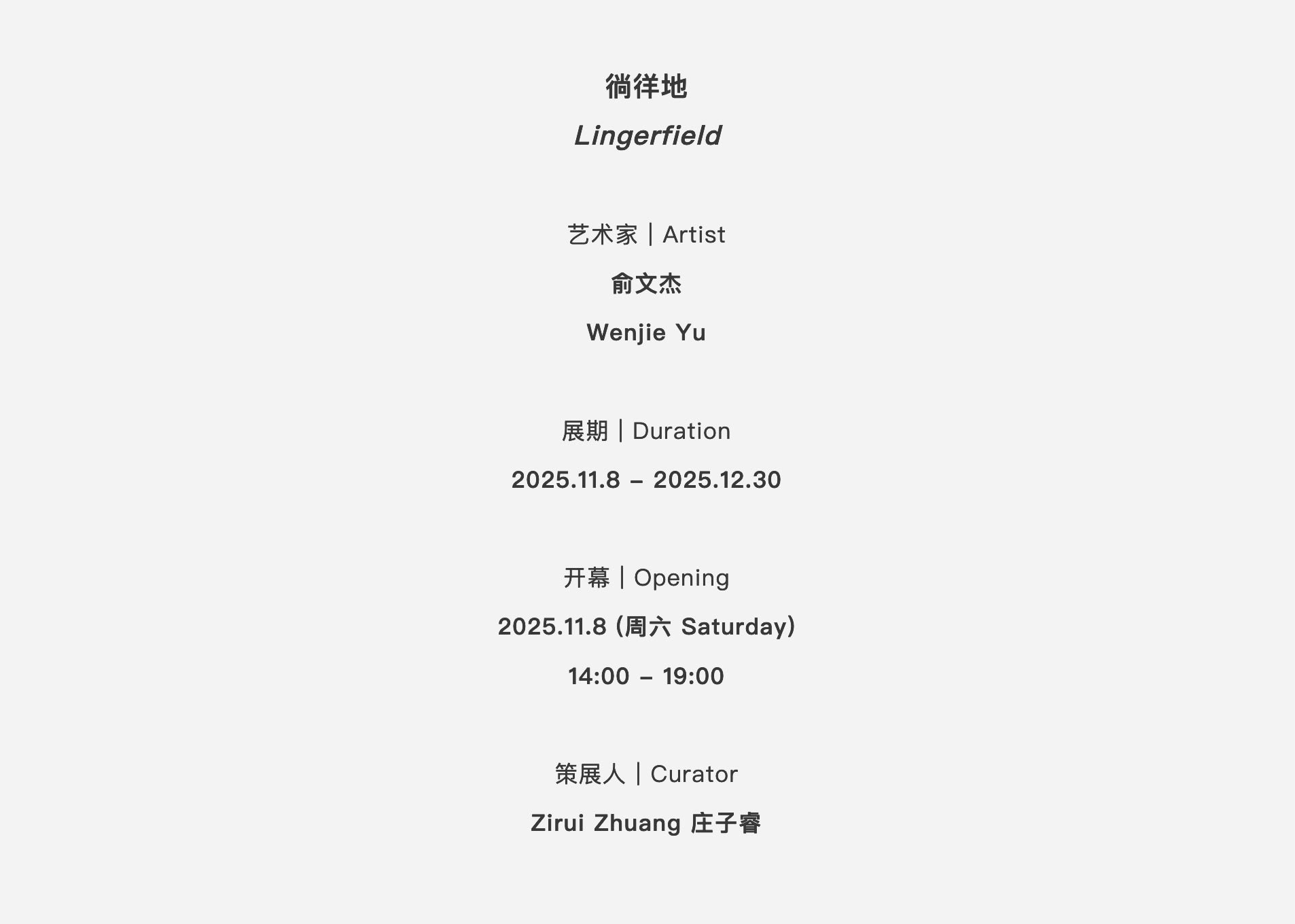
Nan Ke Gallery is pleased to present Lingerfield, a solo exhibition by artist Wenjie Yu, opening on November 8. Lingerfield is not a destination to be reached, but rather a state of continuous becoming. The artist perceives landscapes drifting between material forms, and plains where consciousness deposits itself again and again between dream and reality. Yu’s paintings emerge within this “in-between zone” — neither purely a world of images nor entirely a territory of language, but an ecological interface where light and shadow, form and formlessness, spirit and matter intertwine. Here, perception does not rely solely on the dominance of vision, but grows in a more primitive, tactile manner: like the roots of plants slowly spreading through the clay of time; like echoes of dreams reverberating through the moist layers of memory.
“Lingering” implies a refusal of fixed arrival and, at the same time, the persistence of generation. What Yu constructs on canvas is precisely this logic of purposeless growth — threads wander, layers of color breathe, and fibers shuttle repeatedly between surface and depth. They do not point toward specific imagery, but instead trace the movement of sensation itself: from the withdrawal of sight, to the hibernation of spirit, and the awakening of consciousness. Each painting becomes an ecological node, recording how perception transforms, decays, and regenerates across shifting phases.
Lingerfield is ultimately a meditation on the question of how perception exists. Painting here is not a final outcome but a continuous process. Rather than mere representation, Yu focuses on the breath of the work itself. These paintings invite us to relearn how to feel — how to touch light in the dark, how to listen to the voice of matter before language takes shape, and how, in lingering, we rediscover the point where self-awareness begins.
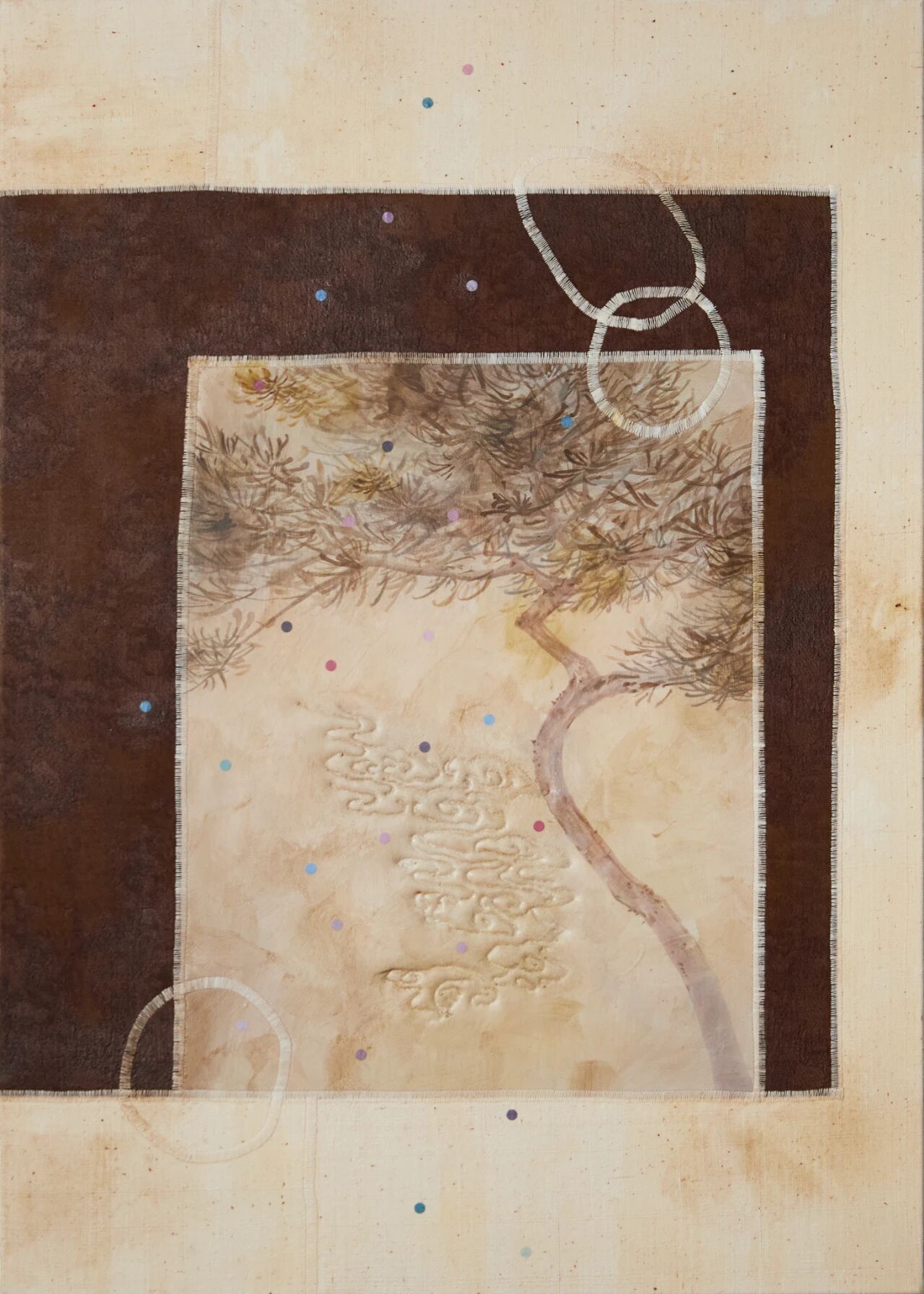 Wenjie Yu
Wenjie YuAs above, so below#14, 2025
Cotton cloth, linen, elastic fabric, cotton sewing thread, sand, soft pastel, resin and wood paint
70h x 50w cm
© Courtesy of the artist
Act I: The Curtain Call of Perception — Echoes of Touch and the Inward Turn of the Senses
Standing before Wenjie Yu’s paintings, we are compelled to witness the retreat of vision. It is not that we are unable to see, but that the very logic of seeing has lost its sovereignty. Objects, images, and meanings begin to collapse in their stability, replaced by a sensory structure that folds inward. Fabric, pigment, stitches, and color fields do not collaborate to form a picture; instead, through tension, folding, and suturing, they generate a tactile ecology from within.
In the Night Soil series, layers of deep blue form a shifting background where plant roots hang and drift, intertwining like rhizomes in the darkness of soil or like seaweed suspended in slow underwater motion. They have no fixed form, existing instead in a state of biological suspension—at once like newborn roots seeking attachment and decaying fibers dissolving within fluid. The image, therefore, is not a stable depiction but a latent habitat: an ecological interface continually generating and eroding itself.
The fibers and stitch-lines do not serve the conventional painterly function of contour or gesture. Rather, they operate as a spore-like mechanism of diffusion, wandering across the surface and germinating new points of contact at the margins. Some threads are almost devoured by the blue background, leaving only a faint gleam—like the invisible traces of lichens creeping across stone. Others form knots through overlap and entanglement, becoming local clusters of proliferation like root nodules or coral. Here, visual dominance withdraws; what we perceive is not the identification of an image but the tactile tracking of a process—one that continuously breeds, disperses, and differentiates.
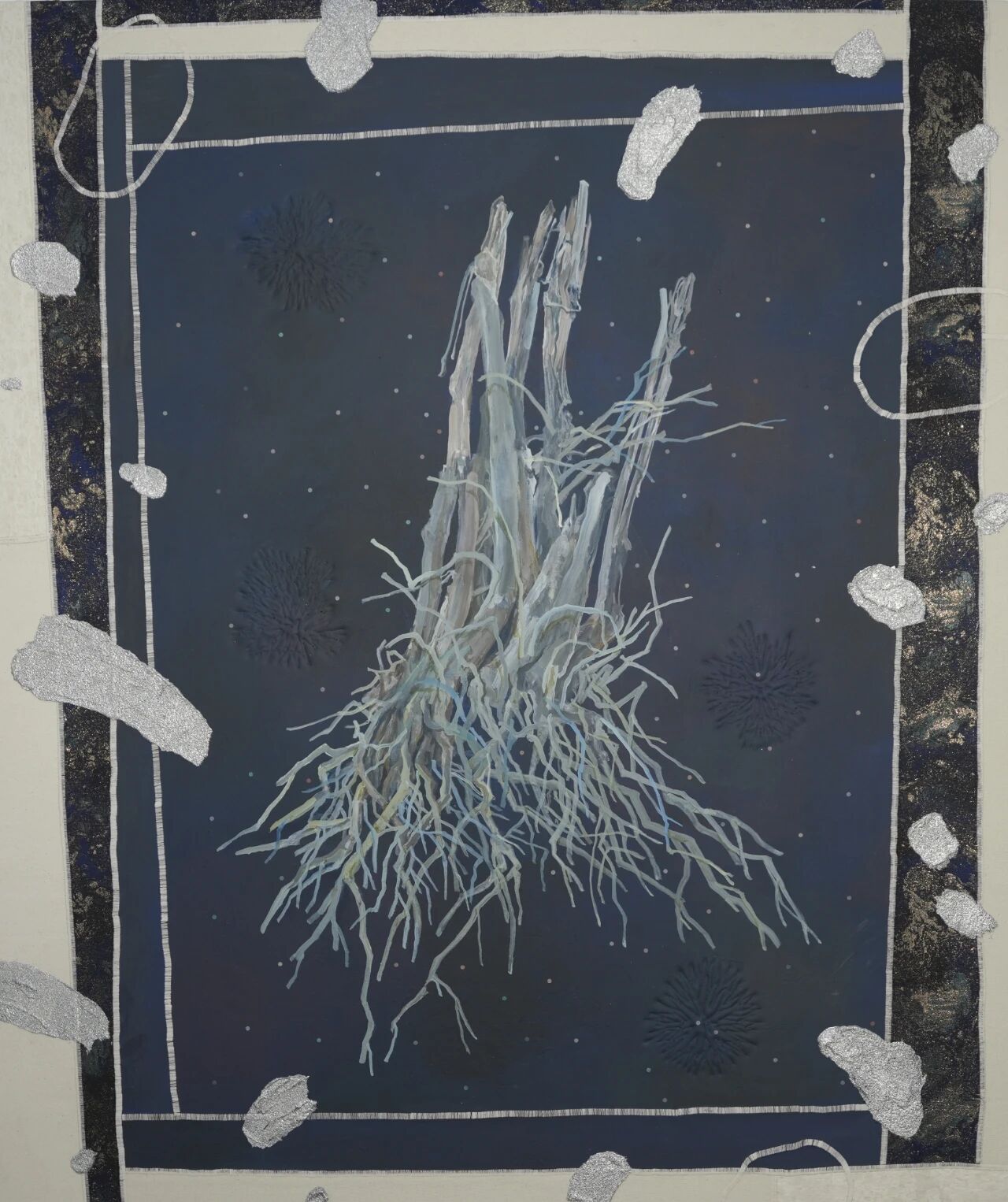
Wenjie Yu
Night soil#2, 2025
Cotton cloth, linen, elastic fabric, cotton sewing thread, sand, soft pastel, resin and wood paint
120h x 100w cm
© Courtesy of the artist
The experience of looking thus resembles observing a microbial colony in a humid environment, suspended between growth and decay, with no clear beginning or end. Confronted with these floating fibers, the viewer’s perception is compelled to transform—from gazing to touching, from recognizing objects to sensing relations. As Deleuze and Guattari observed, life’s expansion does not follow the vertical logic of a tree but the horizontal wanderings of a rhizome, interwoven and non-hierarchical. The Night Soil series embodies precisely such a rhizomatic tactile space: it has no center, no final image—only the relational growth that spreads among materials.
Thus, what we see here are not objects but ecological movements: fiber, cloth, and pigment intertwining, dividing, and reproducing, revealing how perception grows, perishes, and regenerates in darkness. Touch becomes the primary agent of growth; vision merely bears witness.
The Room series extends this tactile ecology into the dimension of space. The checkerboard grid—once the emblem of order and control, the quintessential symbol of visual civilization—implied measurement, boundary, and rational mastery. Yet here, that order loosens beneath the spectral traces of footsteps. The grid, like trampled earth, loses its planar rigidity, retaining only mottled impressions. It ceases to be an abstract geometry and becomes a walked-upon surface, carrying the residual energy and pulse of bodily movement.
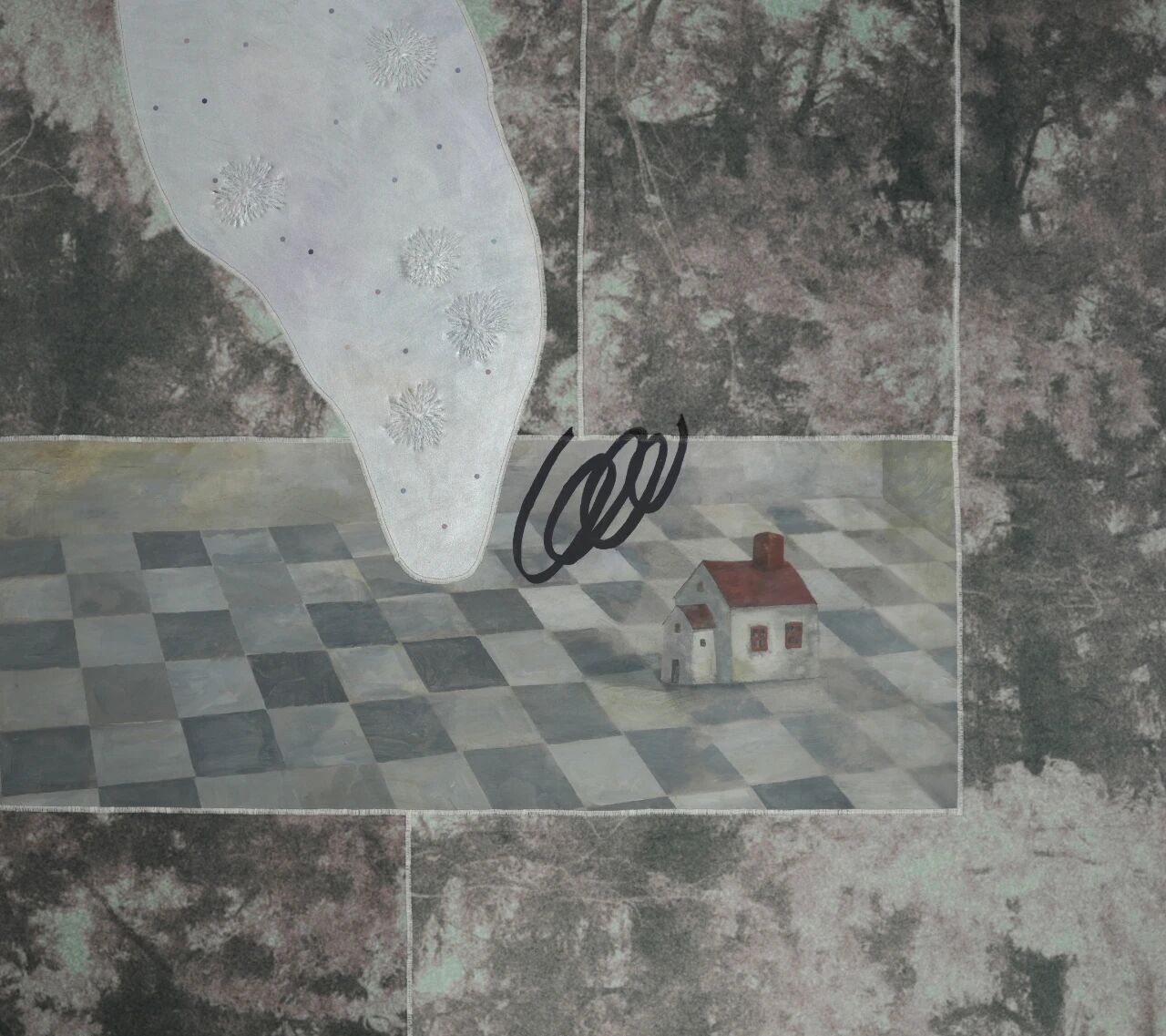
Wenjie Yu
Room#13, 2025
Cotton cloth, velvet, elastic fabric, cotton sewing thread, sand, soft pastel, resin and wood paint
120h x 135w cm
© Courtesy of the artist
Stitches no longer outline or describe; they spread like mycelia through humus, unanchored and directionless. They thread through seams of fabric, resembling microbial fibers creeping beneath soil—maintaining an invisible circulatory system. The shadows within the grid resemble projections of tree shadows: mottled, flickering, and breathing across the surface, bringing a temporal tremor. Tree shadows possess no fixed boundary; they tear and reassemble through the flux of wind and light, forming fleeting yet recurring traces of space.
From a spatial perspective, these works dismantle the depth imposed by perspective and establish instead a logic of surface. Space is no longer a geometric container but a porous soil, a skin penetrated by light and shadow—able to absorb and to leak, to retain memory and to dissolve trace. Encountering the Room series feels less like viewing an image and more like approaching a patch of damp earth or standing beneath trembling branches, where each breath or movement alters the surface form.
Thus, the Room series reveals a tactile ecology of space: the geometric order of the grid is torn open by footsteps, stitches, and shadows. It withdraws from visual logic to become a sensorial habitat governed by growth, erosion, decay, and renewal. Here, space is not a fixed stage but a living skin, constantly invaded by vitality, inscribed by time, and regenerated through its own vulnerability.
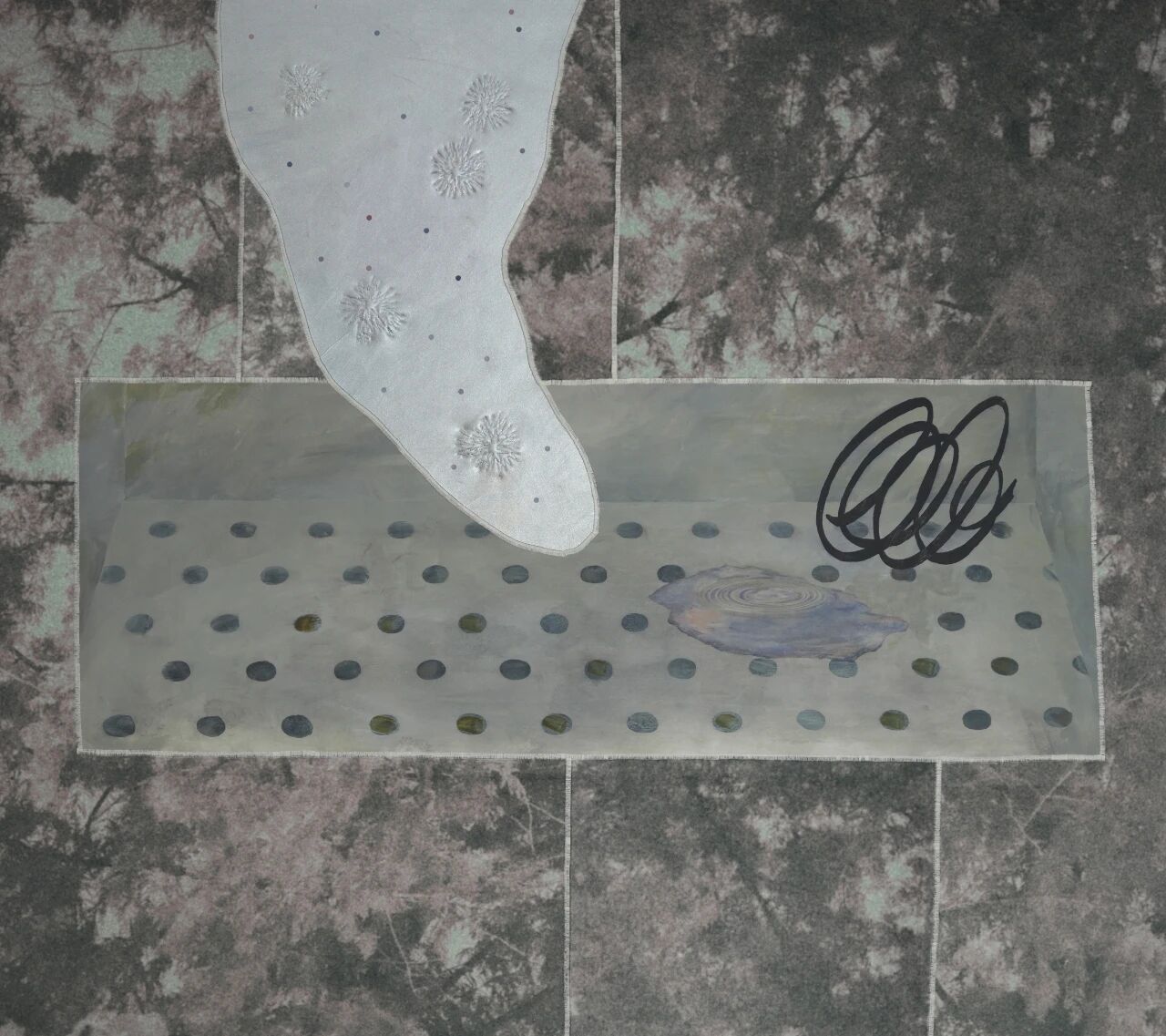
Wenjie Yu
Room#15, 2025
Cotton cloth, velvet, elastic fabric, cotton sewing thread, sand, soft pastel, resin and wood paint
120h x 135w cm
© Courtesy of the artist
Together, these works articulate an ecological logic of touch: vision recedes, and space ceases to be an abstract frame, transforming instead into a synchronous field of biological and luminous processes. Grids, dotted projections, and footprints overlap across the same surface, forming a rhizomatic topology—without center, without terminus, marked only by lateral proliferation, fragmentation, and rebirth.
This is the embodiment of what Freud once called the “late body”—a body already withdrawn, leaving behind a surface that can be sutured, decomposed, and covered again by light and shadow. It is no longer a collection of organs but a habitat—ceaselessly invaded, mended, rewritten by time. Vision here is demoted; it ceases to be an entrance to the world, functioning instead as witness—a silent recorder of the slow movement of matter and temporality through cycles of growth and erosion.
If the Room series constructs a tactile ecology in form, then spiritually it also performs an archaeology of interiority. The trampled ground becomes a stratum of consciousness; the spreading stitches, a growth of memory. Within this inner landscape of fabric and fiber, Wenjie Yu seeks reunion with fragments of the self. This is not the return of recollection but a re-suturing of psychic fragments. Each fold and each scar functions as a psychological stitch—mending, tearing, and healing again upon the skin of time. Thus, the Room ceases to be a spatial enclosure and becomes a landscape within the body—both refuge and ruin, both vessel of present awareness and fermenting bed of memory. The viewer, too, is drawn into this inner echo chamber—listening as the self reemerges between the layers of light, matter, and time.
The curtain call of perception is therefore not an ending but a material cycle. Roots twist in darkness; spores scatter on the surface; mycelia stretch through cracks; the shadows of footsteps press into fabric-as-soil. Together they build a theatre of touch—an ecological stage where perception, like plants, undergoes the rhythm of germination, decay, and rebirth. Fabric, thread, and pigment are no longer neutral media but catalysts through which the senses find renewal within the logic of ecology.
Standing before these works, we hear how touch breaks free from the logic of the image, how it breathes again within the depth of matter. This is a wordless pantomime; yet precisely because it is silent, it resonates with solemn force—a subterranean hum of growth beyond vision, trembling through the seams of night, reminding us that the life of sensation never ends. It merely continues—ecologically, lingeringly—to live.
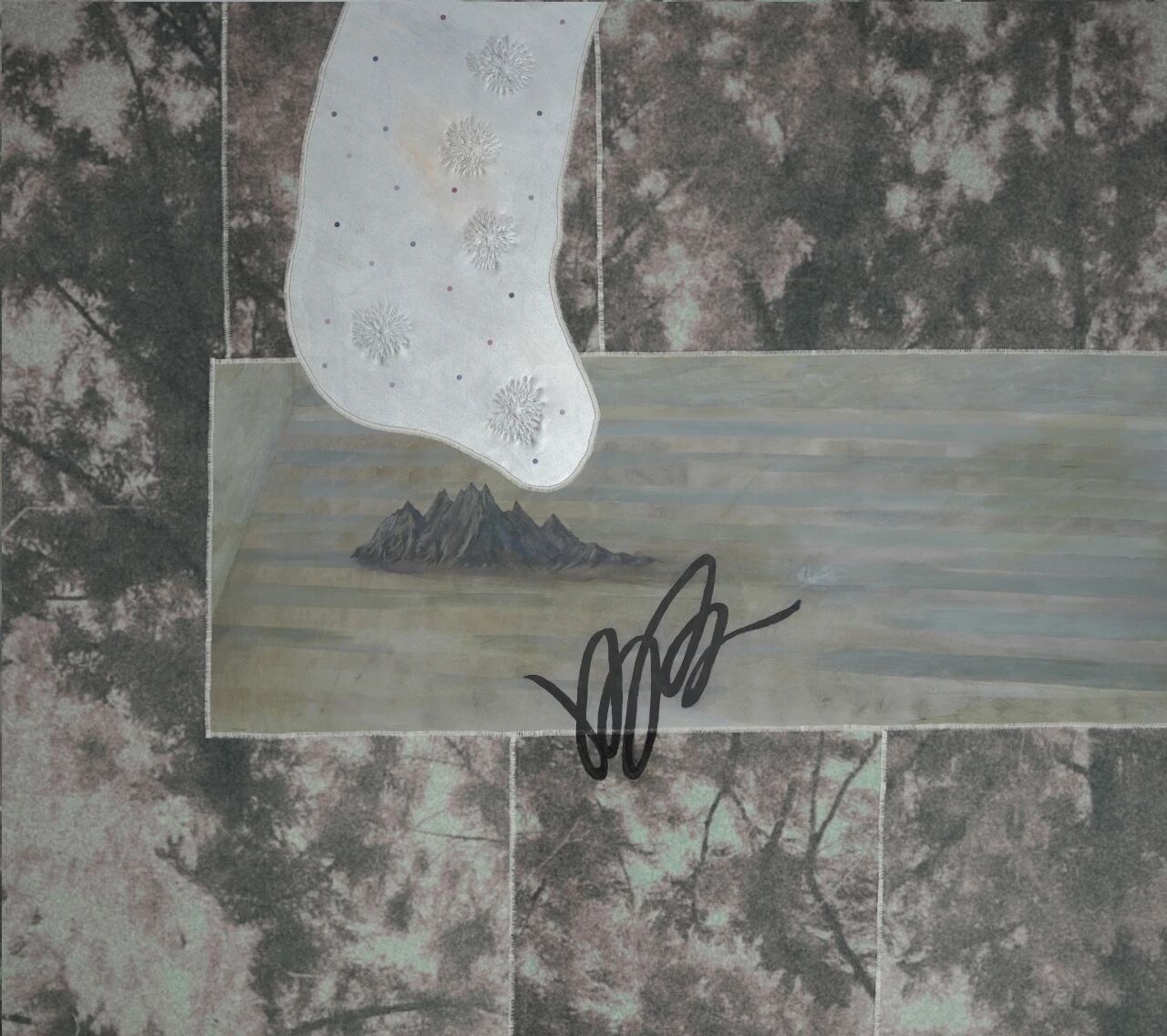
Wenjie Yu
Room#14, 2025
Cotton cloth, velvet, elastic fabric, cotton sewing thread, sand, soft pastel, resin and wood paint
120h x 135w cm
© Courtesy of the artist
Act II: The Lurkers in Shadow — The Lightless Evolution of Psychic Structures
In Wenjie Yu’s paintings, the retreat of light does not mark an end but the beginning of another kind of genesis. The forms that linger in darkness no longer depend on the contours of the visible world; they develop quietly at the edges of perception—like a nervous system germinating in obscurity, a silent yet continuous psychic metabolism. Once light withdraws, the image enters another mode of existence: it no longer appears but continues to breathe, divide, and reorganize at a low frequency.
As Gilbert Simondon reminds us, the individual is never a fixed entity but a process of individuation. The structures emerging in Yu’s works exist precisely within this process—they are neither image nor symbol but the self-organization of psychic energy across the surface of matter. The fibers, stains, circular forms, and cross-sections are not results of composition but manifestations of the formative process itself. The red rings, broken perimeters, and half-geometric frames resemble traces of mental activity inscribed upon a visual membrane. They hint at a continuous sending and returning, like neurotransmitters passing through the delicate gap of a synapse. Every diffusion of pigment and every rupture of line marks another crossing of signal: information does not arrive—it flows.
This world belongs not to light but to the productivity of darkness. Darkness is not emptiness; it is a density of incubation. Within faded fabric, sedimented pigment, and dissolving edges, new structures are born. Red, blue, ochre, and grey no longer form chromatic relationships but the genealogy of psychic intensities: deep blue as the subterranean layer of consciousness, ochre-red as the impulsive surge of memory, and grey-white as the silent residue of reason after collapse. Yu does not depict these psychic states; she allows them to evolve materially—like mold spreading across a wall, or spirit slowly healing through the cracks of its own matter.
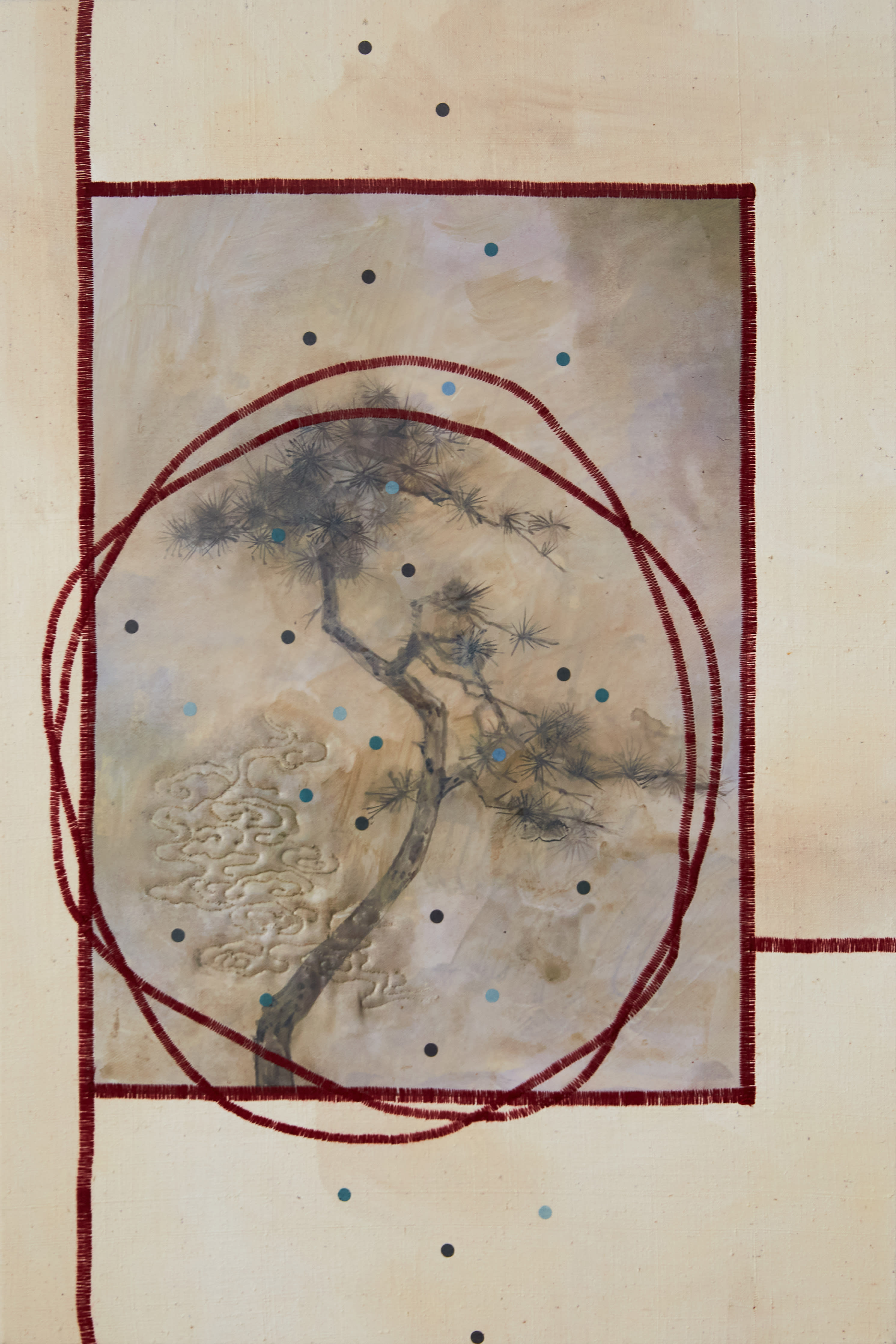
Wenjie Yu
As above, so below#13, 2025
Cotton cloth, linen, elastic fabric, cotton sewing thread, sand, soft pastel, resin and wood paint
60h x 40w cm
© Courtesy of the artist
These images have no center, only movement. Circles intertwine with squares, geometry collides with organism, forming a system of perpetual disturbance. Some shapes seem structured yet are pushed and eroded by invisible currents; some color fields overlap, revealing a transparency like traces of thought resurfacing through matter. Structure here becomes a latent organism—dwelling between the visible and the invisible, sustaining growth through motion rather than stability.
The series As Above, So Below reads like a cross-sectional study of the psychic interface. The vertical division between upper and lower planes, the confinement of circular forms, and the framed images within all point toward a process of mirrored generation—not the reflection of the physical world, but consciousness reflecting upon itself in the absence of light. The interlacing stitches trace the pathways of awareness, threading between two opposing energies: ascent and descent, expansion and collapse, remembrance and forgetting. The faint geometric scaffolds appear as the temporary framework of the psyche—supporting an unseen construction that might collapse at any moment. Yu exposes the temporality of such structures: they are not monuments but living systems of repair and dissolution, constantly reassembling themselves in the dark.
In Unknown Scenery and The Carnival on the Silent Wasteland, this generative process becomes an archaeology of cognitive ruins. The shallow pigment layers, the hollow voids enclosed by stitches, seem fragmentary but act like consciousness scanning itself—not to restore an image but to trace its own absence. Each painting behaves like a self-diagnosing neural network: it tries to reconnect yet is repeatedly interrupted by new waves of disturbance. Thus, every work remains in a state of permanent incompletion: fissures are sutured only to reopen, surfaces veiled only to be penetrated again. It is within this suspended delay that psychic motion becomes visible—it resists fixation, resists definition.
The series The Thought Was Rewoven in the Dark breathes deepest within this scene. Each painting mirrors two facets of consciousness—one sinking into the deep blue night soil, the other rising into a pale luminous veil. Darkness and brightness are not opposites but the two metabolic phases of the mind: thought sedimenting in shadow, then reweaving itself in the absence of light.

Wenjie Yu
The thought was re-woven in the dark#1, 2025
Cotton cloth, linen, elastic fabric, cotton sewing thread, sand, soft pastel, resin and wood paint
80h x 60w cm
© Courtesy of the artist
The barbed, fibrous lines resemble both roots and neural synapses. They do not grow upon the surface but extend secretly through the layers of cloth—crossing, intertwining, repairing themselves. The red rings act as annotations of psychic energy, indicating cycles of transmission and return. Every curve and every stitch marks a moment of re-entanglement, as if thought itself were being constantly undone and rewoven—like a dream replayed, erased, and overwritten upon the same membrane.
In The Thought Was Rewoven in the Dark No. 2, the dark substratum resembles a nocturnal sea of cognition—heavy and viscous. Black woven structures flicker faintly within it, attempting to pierce their own density. In No. 3, the pale surface renders the process translucent; the thorn-like filaments appear to breathe in thin air, regenerating themselves. The relation between black and white here is not one of opposition but of psychic rhythm—one phase sinking into the matter of thought, the other ascending toward awareness.
In these works, “thinking” detaches itself from rational order and becomes an organic act of growth. Thoughts are no longer linear but circulate through the stitched pathways of matter—woven, knotted, loosened, and rewoven again. Yu grants thought a vegetal temporality: slow, diffusive, and without purpose, yet ceaselessly generative. It grows in darkness and continues in the faint warmth of light—just as the psyche evolves within structures that remain unlit.
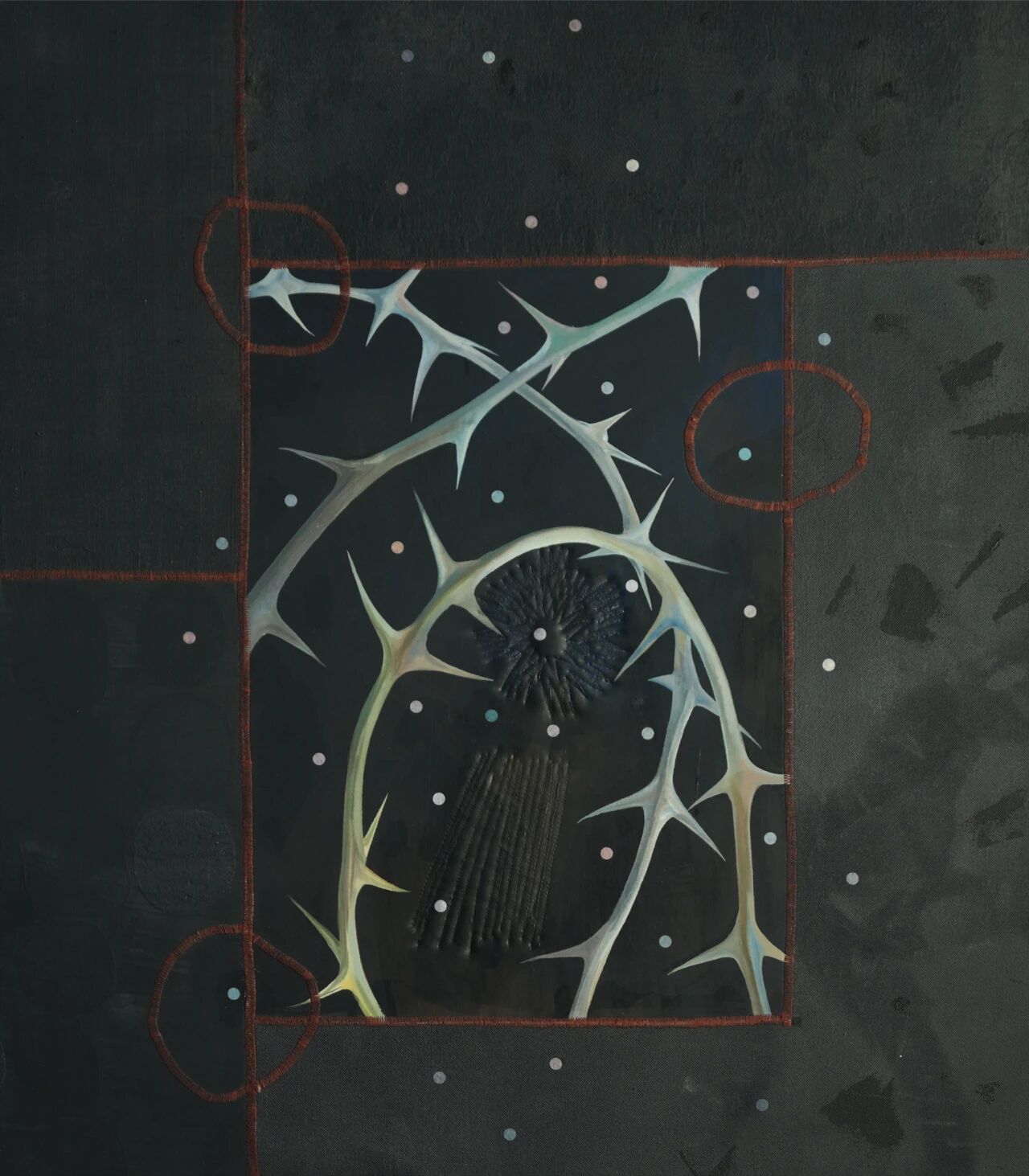
Wenjie Yu
The thought was re-woven in the dark#2, 2025
Cotton cloth, linen, elastic fabric, cotton sewing thread, sand, soft pastel, resin and wood paint
80h x 70w cm
© Courtesy of the artist
Vision here no longer dominates but becomes one sensory node among many. The true center lies in the invisible distribution of energy—matter generating spirit through cycles of disintegration and reformation, spirit generating new material orders through the unlit movement of perception. Each painting becomes not an object to be seen but a field of self-evolution. Facing them, the viewer enters a non-linear system—at once observing and being observed, sensing and being sensed.
The “lurkers in shadow” are thus not metaphors of darkness but figures of a generative mode. They reveal how the psyche continues to act on the invisible plane, how structure evolves in blindness. Darkness is not vacancy but another temporality of perception—a time in which consciousness learns to breathe without light.
Gazing upon these lightless surfaces, we perceive not the absence of image but a deeper form of presence. The seemingly static textures move at imperceptible speed, like dark currents shifting through the geological epochs of the mind. Yu reveals that psychic life does not depend on visibility: it matures in shadow, its morphology woven by time, matter, and the aftershocks of sensation.
This act thus becomes both a commentary on lightless generation and a drama of spiritual ecology. The boundaries of self dissolve; layers of consciousness interpenetrate; structure and sensation co-generate. What we witness is not painting as representation but the evidence of psychic labor in the dark—a silent motion, a birth accomplished in the unseen.

Wenjie Yu
The thought was re-woven in the dark#3, 2025
Cotton cloth, linen, elastic fabric, cotton sewing thread, sand, soft pastel, resin and wood paint
80h x 70w cm
© Courtesy of the artist
Act III: The Threshold Grammar of Dawn Consciousness — The Fissural Construction from Dream to Form
Dawn is not morning; it is a fissure torn open after the night has lasted too long. What appears to be light is, in truth, a transformation of darkness—an image of its exhaustion, a final surge before potential fades. We are reluctant to admit that the residual heat of dreams seeps into waking reality through the cracks of consciousness, yet it does—secretly, precisely, and without fail.
In this act, Wenjie Yu’s language becomes thinner, almost translucent. Stitches cease to close, colors begin to surge, structures expand like tides pushing against the boundaries of the known. The fibers that once lurked in the night are now awakened by the faint light of dawn. Forms loosen—they are no longer threads adrift in darkness but bodies lightly touched by dream. You cannot tell what exactly is being depicted, but you know it is that fragile scene lingering at the edge of waking: the violent tremor when potential tries to leap into actuality.
In Not yet Light, a violet mist—like the residue of a dream—is lifted by orange-pink vapors. The image is pulled between two temporalities: the chill of night and the warmth of dawn. A half-transparent, half-decaying plant body rises from within, resembling a fragment of memory struggling to reconstitute itself deep in consciousness. Light here does not illuminate; it is the last breath released in vanishing. Dawn is thus not the beginning of the new, but the forced emergence of form from darkness—bearing the shadow of night and the scent of dream.
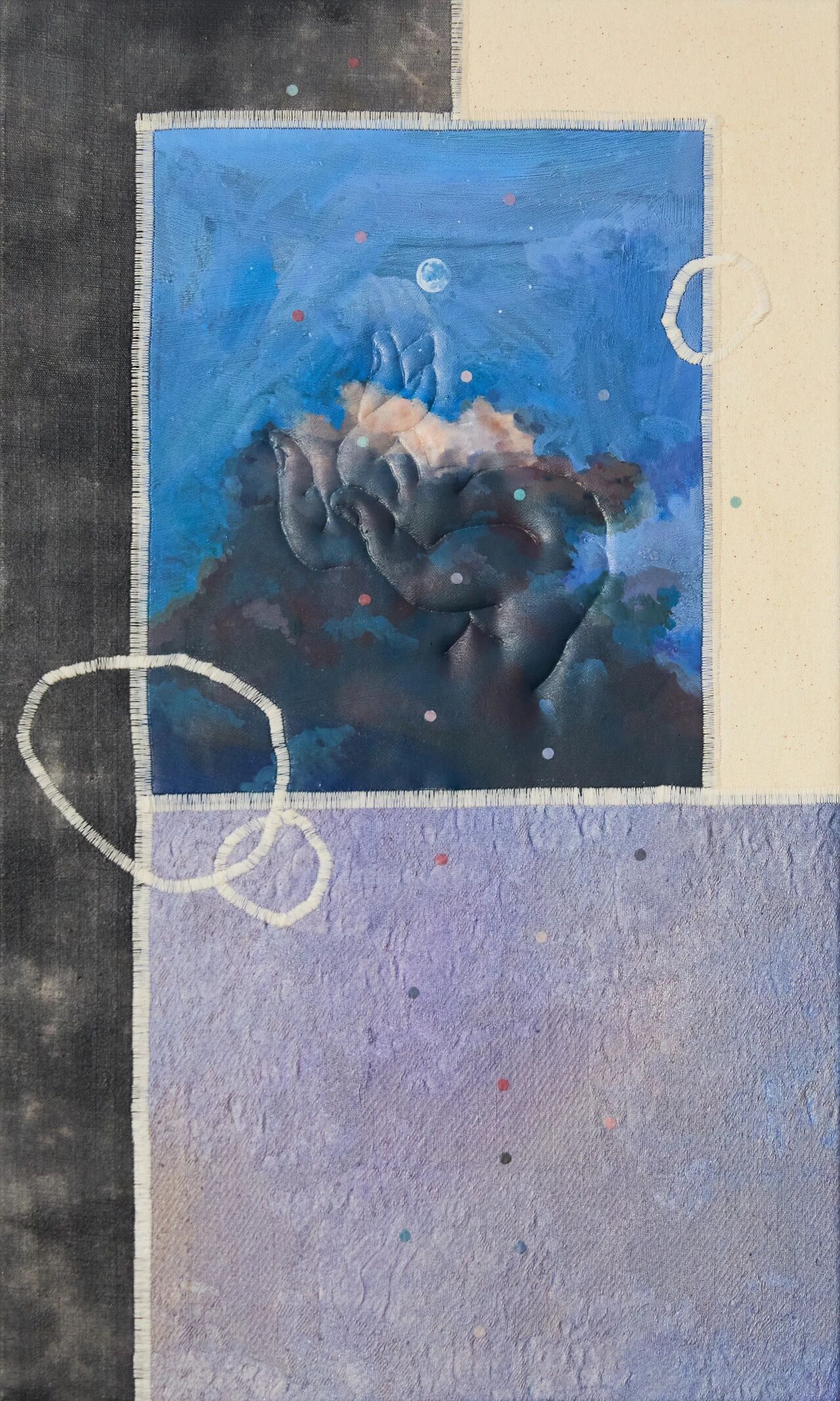
Wenjie Yu
Not yet light#3, 2025
Cotton cloth, linen, elastic fabric, cotton sewing thread, sand, soft pastel, resin and wood paint
50h x 30w cm
© Courtesy of the artist
The series A Prophecy Dreamed at Dawn makes this process of emergence tangible. Massive red petals pulse like blood across the canvas—they are metaphors of flesh and folded languages of dream. The boundary between flower and body blurs: each is at once growth and collapse, opening and tearing. The two paintings mirror one another like a diptych of consciousness—one records the dream’s blossoming, the other the disintegration that follows awakening.
Here, red is not merely color but a mark of vitality. As Gaston Bachelard wrote of the “material imagination,” red trembles with latent potential—it is psychic energy that keeps vibrating within matter. The petals divide, diffuse, and recoil, reenacting the biological unfolding of consciousness. Deleuze and Guattari once called the plant “a horizontally growing body of thought,” refusing the vertical hierarchy of the tree to spread rhizomatically across the surface. Yu’s flowers operate in the same way: they do not grow upward but outward—between fabric and pigment, through percolation and seepage, generating meaning as they wander.
Red becomes here a botany of the psyche—no longer symbolic, but energetic. Jung wrote that the symbols of dreams possess a “biological order,” that each image is the self-replication of psychic energy. In Yu’s paintings, the mechanism of dream production mirrors the reproductive logic of plants: both depend on internal circulation and external diffusion, growing continuously between appearance and concealment.
Seen this way, A Prophecy Dreamed at Dawn is not a narrative of dreaming but a botanical experiment of the dream itself. It renders the residue of dream—the humid matter suspended between consciousness and the unconscious—into floral form. Each fold of petal is a linguistic rehearsal; each fissure, a regeneration of perception. Hélène Cixous once wrote: “The body writes in flowing motion; its sentences are the extensions of blood.” Yu’s flowers embody that writing: they inscribe the grammar of the dream in the rhythm of blood.
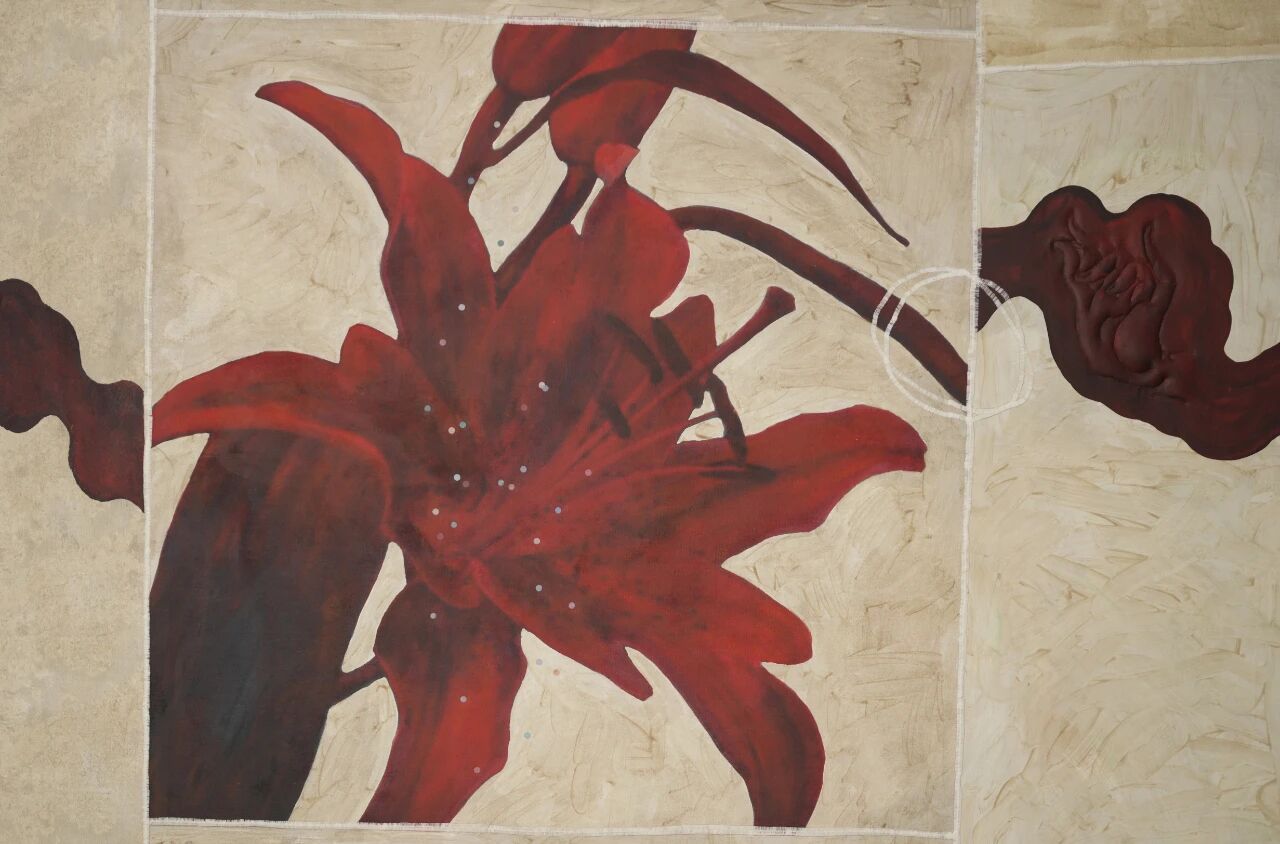
Wenjie Yu
A prophecy dreamed at dawn#3-1, 2025
Cotton cloth, linen, elastic fabric, cotton sewing thread, sand, soft pastel, resin and wood paint
106h x 160w cm
© Courtesy of the artist
Prophecy here is not a foretelling of the future but an echo not yet fully formed. It occurs ahead of time in the cadence of dream, only to arrive belatedly in reality. That delay marks the threshold of dawn consciousness—the point at which the warmth of dream remains while language has not yet clarified itself. As Luce Irigaray suggested, the birth of language is not the onset of reason but an experience of breathing—the quiver of the body before it speaks its first word. Yu’s prophecy resides precisely at this threshold: not as utterance, but as the first respiration of consciousness.
Thus, A Prophecy Dreamed at Dawn is both the epilogue of dreaming and the prelude to speech. It shows how awareness grows like a plant: roots in darkness, blossoms at the edge of light. Language, body, and dream interlace within a single system of growth, composing the grammar of dawn—not as statement, but as continuous revelation, a slow blooming between flesh and spirit.
In The Moment of Emergence, this psychic tension becomes tactile. Pairs of hands surface through a pale white layer—not grasping, but verifying their own existence. The thin grey powder over the surface feels like the skin of awareness; the emergence of hands is consciousness testing itself anew. Here Yu sutures dream and body once more: perception ceases to drift as abstraction and becomes a corporeal breathing that light can touch.
In dialogue with it, Abiding Nowhere offers a quieter, more open mechanism of revelation. It is no longer a theatre of growth or collapse, but a suspended field held by delicate tension. The red petals scattered across a yellowing background do not serve representation; they float, fracture, and whirl in dispersed gestures. Bound and guided by fine red threads, they are simultaneously drawn inward and released by an internal breath. The faint grid beneath does not construct order but acts as a structure-in-growth—its geometry unstable, edges open, nodes tilted—recalling the rhizomatic spatial logic Deleuze and Guattari described: an organic network that does not aim for a center but proliferates outward.
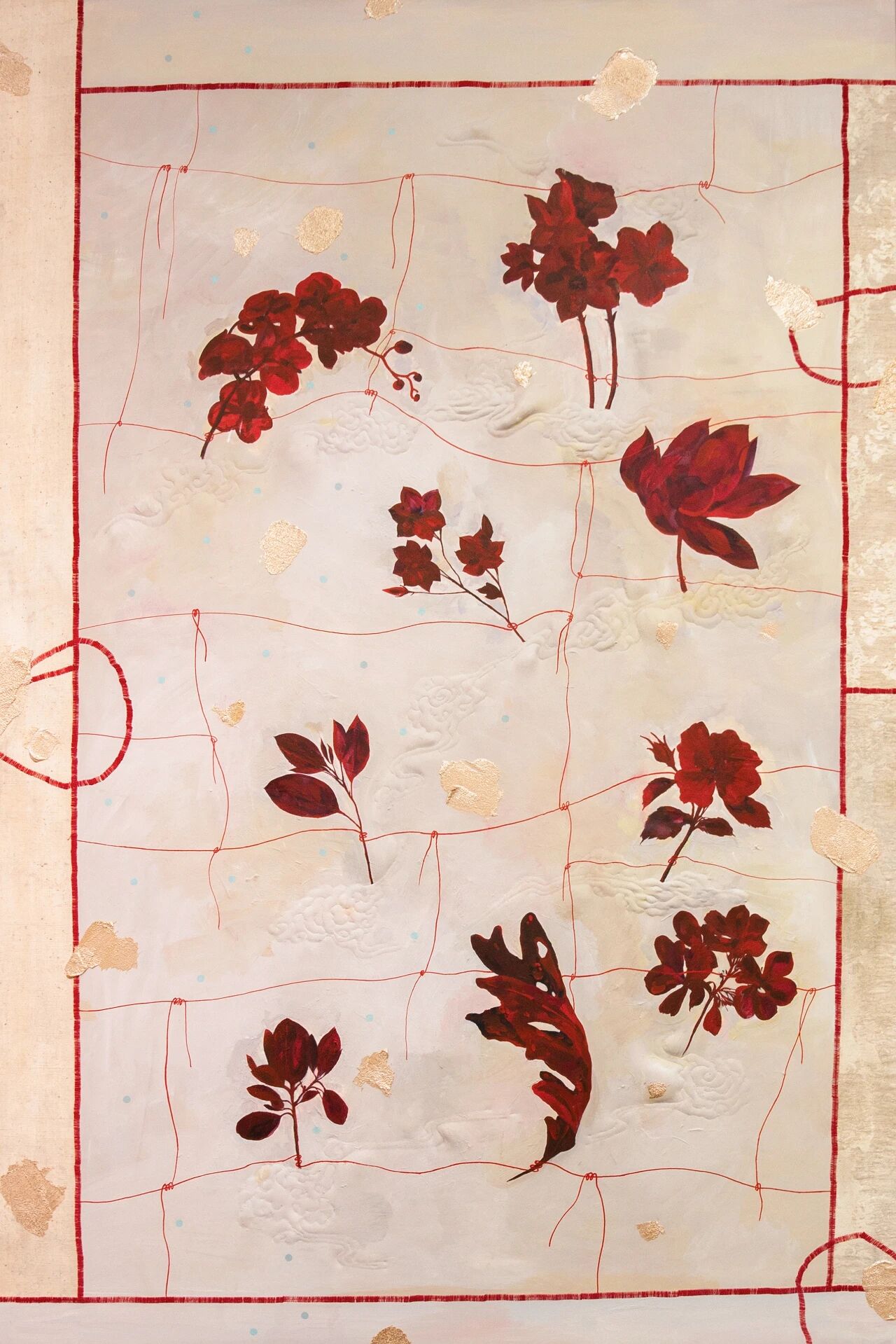
Wenjie Yu
Abiding nowhere#1, 2025
Cotton cloth, linen, elastic fabric, cotton sewing thread, sand, soft pastel, resin and wood paint
150h x 100w cm
© Courtesy of the artist
Within this non-abiding field, the flower image loses its botanical classification and drifts into a state that is almost physiological. It seems at once germinating and decaying—a double temporality of embryology and decomposition. André Leroi-Gourhan noted in Gesture and Speech that the morphology of life always unfolds with a “technical delay,” that the growth of form lags behind consciousness. Yu’s flowers reveal precisely that delay—they are consciousness lagging behind its own embodiment, the psyche catching up with its material skin. The red threads that tether them recall what Georges Bataille called “the downward-growing forms of life”: no longer ascending but expanding outward, toward the ground, toward escape.
The relation between flower and grid, read phenomenologically, may be seen as a surface consciousness. Maurice Merleau-Ponty in The Visible and the Invisible observed that perception is not depth but “the thickness of surface.” Abiding Nowhere inhabits this thickness: the minute oscillations between line and petal, ground and layer, revelation and concealment, transform vision into a tactile event. Granular pigment and powder create a breathable skin; resin and lacquer hold light upon the surface, reflecting and refracting it. The viewer’s gaze is forced to glide rather than penetrate—perception becomes a drifting occurrence rather than an act of recognition.
From an ecological perspective, Abiding Nowhere may also be understood as an ecology of wandering. Tim Ingold, in Lines: A Brief History, writes that a line is not a boundary but a trajectory of movement—a “form of walking.” The red threads across Yu’s canvas are not structures but actions: they record directions of energy and rhythms of breath. The gold flecks and floating particles resemble spores of time, suspended between inhalation and exhalation. The painting thus performs a mycology of temporality—where growth and decay coexist, adhesion and exfoliation occur simultaneously.
Abiding Nowhere is therefore not a painting but an experiment in the lichenology of consciousness. Through the porous weave of fabric, spirit and matter coexist in epiphytic intimacy. The extension of red threads serves both as the path of breathing and the ligament of thought; the scattered petals mark both decay and the germination of memory. “To linger” becomes here a method: to grow where one cannot dwell, to emerge amid instability, to stitch oneself together upon a drifting surface.

Wenjie Yu
Night soil#1, 2025
Cotton cloth, linen, elastic fabric, cotton sewing thread, sand, soft pastel, resin and wood paint
130h x 88w cm
© Courtesy of the artist
It is a lichen of dawn consciousness—refusing clear form, sustained only by fragile physiological tension. These flowers are no longer botanical species but spores of dream; the red-threaded surface is no longer a frame but a membrane of awareness. They remind us that Lingerfield is not a geographical space but a mode of perceptual growth—a psychic habitation that gains vitality through instability, suspension, and drift.
Julia Kristeva once wrote that what escapes language is the true matrix of existence. In these works, Yu seeks precisely that region before language takes shape—where dream and form have yet to divide, where consciousness is still being woven. The threshold grammar of dawn does not indicate clarity of expression but the pre-linguistic night before it: grammar unfixed, meaning still rising slowly from the warmth of dream.
The spatiality of this act thus manifests a blurred visibility. Form no longer obeys perspectival order but connects through floating linkages. Color becomes energy; stitch becomes the rhythm of breath. Dawn’s light does not illuminate but permeates—it reveals matter and spirit simultaneously, allowing consciousness to return from dream to body.
Here, we no longer face an image to be seen but the grammar of perception itself. Fragments of dream, reassembled bodies, nascent language—all intertwine into a threshold system: neither fully awake nor entirely asleep. It is consciousness speaking to itself at the edge of dawn—not to tell us something, but to affirm: you are still alive, still feeling, still speaking at the border between dream and reality.
Thus, “dawn” is no longer a moment in time but a mode of existence—continuing reality through the logic of dream, preserving dream through the logic of reality. The threads once woven in darkness now surface, still warm from the night. They glimmer in the light, breathe through fissures, and bear witness to the rebirth of awareness.
Epilogue: The Surface of Echoes — Between Dream and Matter
When the grammar of dawn begins to fade, Wenjie Yu’s paintings never truly arrive at “morning.” They linger upon an unnamed threshold—where the resonance of night still hums, and the first pulse of light has barely begun. What unfolds across these three acts is not a linear passage from darkness to illumination, but an experiment in the cyclical becoming of perception. Vision, touch, and spirit compose a continuous ecology—interpenetrating, reversing, and translating one another, like mycelia, rhizomes, and dreams cohabiting in the same moist layer of soil.
The Curtain Call of Perception reveals how touch awakens as vision withdraws. The Lurkers in Shadow shows the psyche evolving within the unlit zone. The Threshold Grammar of Dawn Consciousness marks the moment when perception returns to the body, newly born. These three stages do not form a chronology but three phases of circulation: the ecology of the senses, the psychology of growth, and the manifestation of consciousness. They resemble the rhythm of breathing—inhale, pause, exhale—or the threefold movement of geological time: sedimentation, fracture, regeneration.
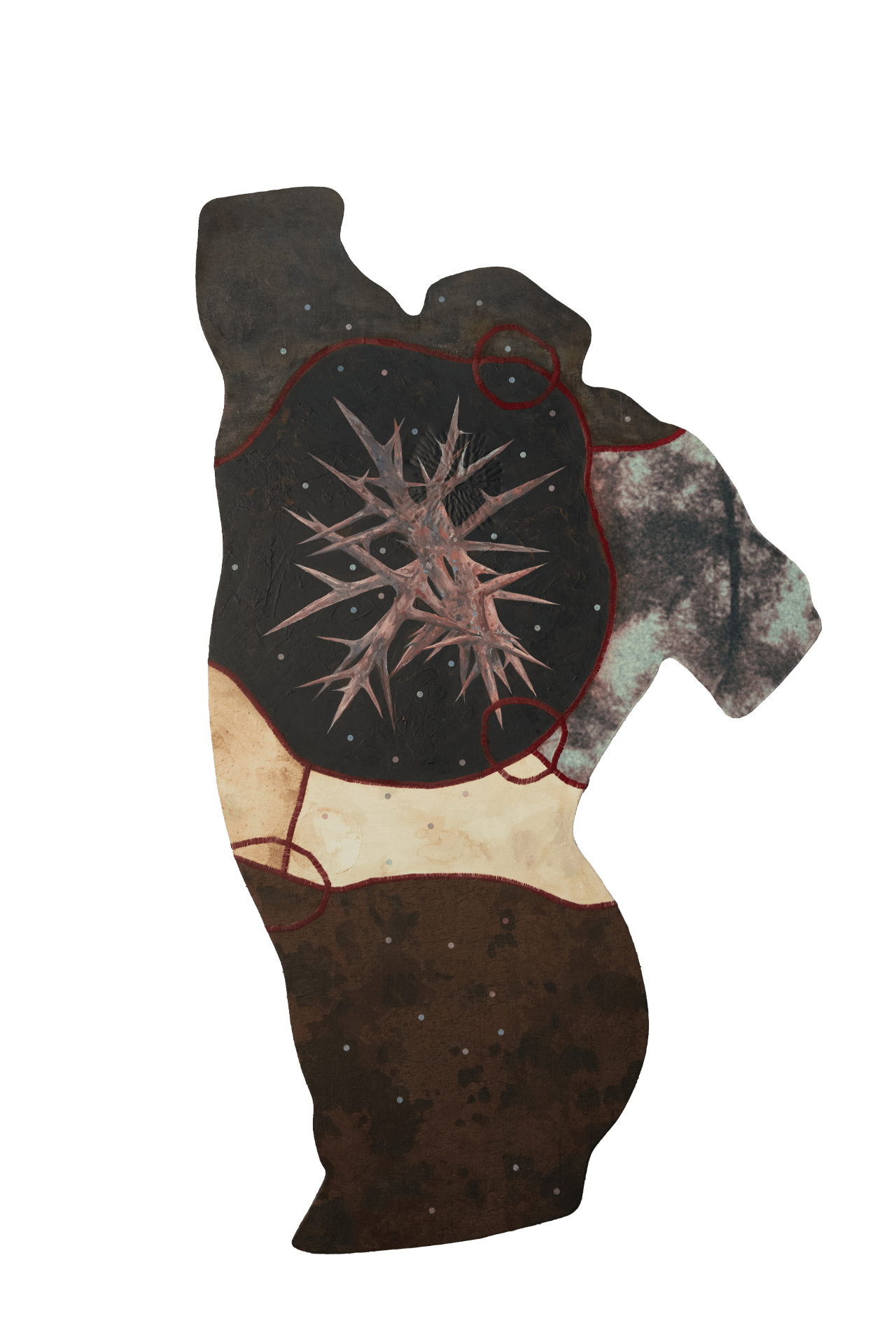
Wenjie Yu
Ecstacy#1, 2025
Cotton cloth, linen, velvet, elastic fabric, cotton sewing thread, sand, soft pastel, resin and wood paint
107h x 62w cm
© Courtesy of the artist
Within this slow ecological drama, the task of the image is redefined. It no longer serves representation but becomes the evidence of becoming. Every layer of fabric, pigment, and stitch corresponds to a process of the psyche’s materialization. Yu allows painting to “de-territorialize” itself—it is at once landscape and cross-section of consciousness, both the root system of plants and the neural network of language. Vision’s retreat, spirit’s incubation, and consciousness’s reappearance converge into an extended epidermis of perception—repeatedly inscribed, corroded, and renewed by the flow of time.
This is not a narrative of closure but a testimony of recurrence. The embers of dream continue to burn beneath the surface; color and fiber keep breathing; the echoes of sensation reverberate through matter with deliberate delay. What stands before us is not a canvas but a living mechanism still unfolding—where, after the departure of light and before the birth of language, the senses continue to search for their own corporeal form.
This is the true dawn of Wenjie Yu’s work: when images cease to be seen and begin to be heard; when dreams cease to be interpreted and begin to be breathed; when matter itself begins to speak. From that moment, dawn no longer belongs to light—it belongs to the renewed growth of perception.
Text by Zirui Zhuang


